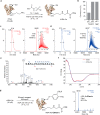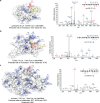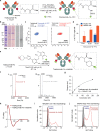Chemo- and Regioselective Lysine Modification on Native Proteins
- PMID: 29473744
- PMCID: PMC5880509
- DOI: 10.1021/jacs.7b12874
Chemo- and Regioselective Lysine Modification on Native Proteins
Abstract
Site-selective chemical conjugation of synthetic molecules to proteins expands their functional and therapeutic capacity. Current protein modification methods, based on synthetic and biochemical technologies, can achieve site selectivity, but these techniques often require extensive sequence engineering or are restricted to the N- or C-terminus. Here we show the computer-assisted design of sulfonyl acrylate reagents for the modification of a single lysine residue on native protein sequences. This feature of the designed sulfonyl acrylates, together with the innate and subtle reactivity differences conferred by the unique local microenvironment surrounding each lysine, contribute to the observed regioselectivity of the reaction. Moreover, this site selectivity was predicted computationally, where the lysine with the lowest p Ka was the kinetically favored residue at slightly basic pH. Chemoselectivity was also observed as the reagent reacted preferentially at lysine, even in those cases when other nucleophilic residues such as cysteine were present. The reaction is fast and proceeds using a single molar equivalent of the sulfonyl acrylate reagent under biocompatible conditions (37 °C, pH 8.0). This technology was demonstrated by the quantitative and irreversible modification of five different proteins including the clinically used therapeutic antibody Trastuzumab without prior sequence engineering. Importantly, their native secondary structure and functionality is retained after the modification. This regioselective lysine modification method allows for further bioconjugation through aza-Michael addition to the acrylate electrophile that is generated by spontaneous elimination of methanesulfinic acid upon lysine labeling. We showed that a protein-antibody conjugate bearing a site-specifically installed fluorophore at lysine could be used for selective imaging of apoptotic cells and detection of Her2+ cells, respectively. This simple, robust method does not require genetic engineering and may be generally used for accessing diverse, well-defined protein conjugates for basic biology and therapeutic studies.
Conflict of interest statement
The authors declare no competing financial interest.
Figures








Similar articles
-
Lysine Bioconjugation on Native Albumin with a Sulfonyl Acrylate Reagent.Methods Mol Biol. 2019;2033:25-37. doi: 10.1007/978-1-4939-9654-4_3. Methods Mol Biol. 2019. PMID: 31332745
-
Chemoselective and Site-Selective Lysine-Directed Lysine Modification Enables Single-Site Labeling of Native Proteins.Angew Chem Int Ed Engl. 2020 Jun 22;59(26):10332-10336. doi: 10.1002/anie.202000062. Epub 2020 Apr 20. Angew Chem Int Ed Engl. 2020. PMID: 32171045
-
Stoichiometric and irreversible cysteine-selective protein modification using carbonylacrylic reagents.Nat Commun. 2016 Oct 26;7:13128. doi: 10.1038/ncomms13128. Nat Commun. 2016. PMID: 27782215 Free PMC article.
-
Development and Recent Advances in Lysine and N-Terminal Bioconjugation for Peptides and Proteins.Molecules. 2023 Jan 21;28(3):1083. doi: 10.3390/molecules28031083. Molecules. 2023. PMID: 36770752 Free PMC article. Review.
-
N-Acyl-N-alkyl/aryl Sulfonamide Chemistry Assisted by Proximity for Modification and Covalent Inhibition of Endogenous Proteins in Living Systems.Acc Chem Res. 2025 Jan 7;58(1):87-100. doi: 10.1021/acs.accounts.4c00628. Epub 2024 Dec 11. Acc Chem Res. 2025. PMID: 39661110 Review.
Cited by
-
Calibrating Catalytic DNA Nanostructures for Site-Selective Protein Modification.Chemistry. 2022 Sep 12;28(51):e202200895. doi: 10.1002/chem.202200895. Epub 2022 Jul 25. Chemistry. 2022. PMID: 35726668 Free PMC article.
-
Human Serum Albumin Labelled with Sterically-Hindered Nitroxides as Potential MRI Contrast Agents.Molecules. 2020 Apr 8;25(7):1709. doi: 10.3390/molecules25071709. Molecules. 2020. PMID: 32276437 Free PMC article.
-
Unveiling Druggable Pockets by Site-Specific Protein Modification: Beyond Antibody-Drug Conjugates.Front Chem. 2020 Oct 21;8:586942. doi: 10.3389/fchem.2020.586942. eCollection 2020. Front Chem. 2020. PMID: 33195086 Free PMC article.
-
Manganese-Catalyzed Electrochemical Diazidation of Dehydroalanine Peptides.Adv Sci (Weinh). 2025 Jul;12(28):e2502711. doi: 10.1002/advs.202502711. Epub 2025 May 11. Adv Sci (Weinh). 2025. PMID: 40349176 Free PMC article.
-
Advancing Covalent Ligand and Drug Discovery beyond Cysteine.Chem Rev. 2025 Jul 23;125(14):6653-6684. doi: 10.1021/acs.chemrev.5c00001. Epub 2025 May 22. Chem Rev. 2025. PMID: 40404146 Free PMC article. Review.
References
Publication types
MeSH terms
Substances
LinkOut - more resources
Full Text Sources
Other Literature Sources
Research Materials
Miscellaneous

